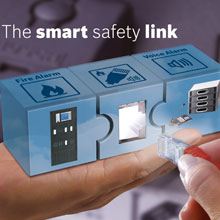 |
| The fire alarm panel is equipped with IP-communication interface to public address and voice evacuation system |
In the event of a fire, evacuation of the area or building concerned is always the top priority. Therefore, there is a strong need to link fire alarm and public address systems with a reliable and bi-directional connection. The latest version of the Modular Fire Panel 5000 Series from Bosch fulfills this requirement in a customer–friendly way. The fire alarm panel is now equipped with an IP-communication interface to the public address and voice evacuation system, Praesideo, ensuring a flexible and future-proof connection between both systems.
The alarm panel and evacuation system are connected via Ethernet, resulting in several major benefits. Firstly, apart from the usual system-IP-components, it removes the need to install additional hardware modules and complex cabling, which leads to time and cost savings during installation and wiring. At the same time, the risk of incorrect cabling is eliminated, as only one Ethernet connection is required as opposed to multiple-cable connections in the past. Secondly, thanks to extensive diagnostic functions, there is a continuous and fast analysis of the connection state, resulting in clear feedback. Finally, should the system be extended in the future, no complex and fault-prone re-cabling of the hardware connections is necessary.
“The new Fire Panel offers higher flexibility in terms of project design,” explains Philip Duerringer, team leader at Bosch Security Systems. “It allows for customer-specific and complex evacuation rules to be programmed, and is future-proof due to the ease with which the system can be expanded without having to install new hardware.”
The interface conforms to EN 54 standards and, since September 2012, has been enhanced by way of IP networking, making it ideal for large-scale installations requiring numerous outlets, or for such complex systems as airports and railway stations. Last but not least, the system can be connected to an existing third-party building management system via OPC or by way of a soft-ware development kit.




